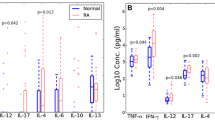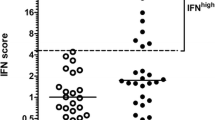Abstract
There is paucity of literature on the association of peripheral blood cytokine patterns with patient demographics and disease variables in rheumatoid arthritis (RA). We test the hypothesis that there may be differences in peripheral blood levels of inflammatory cytokines in RA subjects according to various disease variables. In this case, we could identify peripheral blood cytokine markers that correlate with different disease variables. Forty-two seropositive RA patients were characterized according to the age at onset, gender, disease duration, severity, activity and ACR functional class. The production levels in mitogen-stimulated PBMCs of five pro-inflammatory cytokines (IFNγ, TNFα, TNFβ, IL-8, IL-18) and three anti-inflammatory cytokines (IL-4, IL-10, IL-13) were evaluated in these patients and in healthy controls. Several new findings emerge: (1) higher levels of IL-4 correlate with female gender, milder disease, non-erosive disease, and earlier age at onset; (2) higher levels of IL-10 correlate with the requirement of ≤2 DMARDs; (3) higher levels of IL-18 correlate with non-erosive disease and younger age at onset; (4) higher TNFβ levels correlate with older present age of patients; and (5) higher IL-8 levels correlate with established/late disease. There are several interesting differences in cytokine patterns with respect to age at onset, current age, disease severity, and the number of DMARDs the patients require.



Similar content being viewed by others
References
Arend WP, Dayer JM (1990) Cytokines and cytokine inhibitors or antagonists in rheumatoid arthritis. Arthritis Rheum 33(3):305–315
Arend WP (2001) Physiology of cytokine pathways in rheumatoid arthritis. Arthritis Rheum 45(1):101–106
Arnett FC, Edworthy SM, Bloch DA, McShane DJ, Fries JF, Cooper NS et al (1988) The American rheumatism association 1987 revised criteria for the classification of rheumatoid arthritis. Arthritis Rheum 31(3):315–324
Prevoo ML, van ‘t Hof MA, Kuper HH, van Leeuwen MA, van de Putte LB, van Riel PL (1995) Modified disease activity scores that include twenty-eight-joint counts. Development and validation in a prospective longitudinal study of patients with rheumatoid arthritis. Arthritis Rheum 38(1):44–48
Fransen J, Creemers MC, van Riel PL (2004) Remission in rheumatoid arthritis: agreement of the disease activity score (DAS28) with the ARA preliminary remission criteria. Rheumatology (Oxford) 43(10):1252–1255
Harris Jr ED (2001) Treatment of active rheumatoid arthritis. UpToDate© 2001, version 9.1. Ref type: Internet communication
Conaghan PG, Green MJ, Emery P (1999) Established rheumatoid arthritis. Baillieres Best Pract Res Clin Rheumatol 13(4):561–575
Scott DL, Houssien DA (1996) Joint assessment in rheumatoid arthritis. Br J Rheumatol 35(Suppl 2):14–18
van Gestel AM, Prevoo ML, van ‘t Hof MA, van Rijswijk MH, van de Putte LB, van Riel PL (1996) Development and validation of the European league against rheumatism response criteria for rheumatoid arthritis. Comparison with the preliminary American college of rheumatology and the world health organization/international league against rheumatism criteria. Arthritis Rheum 39(1):34–40
Guidelines for the management of rheumatoid arthritis: 2002 update. Arthritis Rheum 46(2):328–346
Arend WP (2001) Cytokine imbalance in the pathogenesis of rheumatoid arthritis: the role of interleukin-1 receptor antagonist 85. Semin Arthritis Rheum 30(5 Suppl 2):1–6
Mosmann TR, Sad S (1996) The expanding universe of T-cell subsets: Th1, Th2 and more. Immunol Today 17(3):138–146
Firestein GS (2005) Etiology and pathogenesis of rheumatoid arthritis. In: Harris Jr ED, Budd RC, Genovese MC, Firestein GS, Sargent JS, Sledge CB (eds) Kelley’s textbook of rheumatology. 7th edn. Elseiver, Philadelphia, pp 1013–1042
Dolhain RJ, van der Heiden AN, ter Haar NT, Breedveld FC, Miltenburg AM (1996) Shift toward T lymphocytes with a T helper 1 cytokine-secretion profile in the joints of patients with rheumatoid arthritis. Arthritis Rheum 39(12):1961–1969
Kusaba M, Honda J, Fukuda T, Oizumi K (1998) Analysis of type 1 and type 2 T cells in synovial fluid and peripheral blood of patients with rheumatoid arthritis. J Rheumatol 25(8):1466–1471
Haddad A, Bienvenu J, Miossec P (1998) Increased production of a Th2 cytokine profile by activated whole blood cells from rheumatoid arthritis patients. J Clin Immunol 18(6):399–403
Raghupathy R (2001) Pregnancy: success and failure within the Th1/Th2/Th3 paradigm. Semin Immunol 13(4):219–227
Wegmann TG, Lin H, Guilbert L, Mosmann TR (1993) Bidirectional cytokine interactions in the maternal-fetal relationship: is successful pregnancy a TH2 phenomenon? Immunol Today 14(7):353–356
Doria A, Iaccarino L, Arienti S, Ghirardello A, Zampieri S, Rampudda ME et al (2006) Th2 immune deviation induced by pregnancy: the two faces of autoimmune rheumatic diseases. Reprod Toxicol 22(2):234–241
Ostensen M, Forger F, Nelson JL, Schuhmacher A, Hebisch G, Villiger PM (2005) Pregnancy in patients with rheumatic disease: anti-inflammatory cytokines increase in pregnancy and decrease post partum. Ann Rheum Dis 64(6):839–844
Jawaheer D, Lum RF, Gregersen PK, Criswell LA (2006) Influence of male sex on disease phenotype in familial rheumatoid arthritis. Arthritis Rheum 54(10):3087–3094
O’Mahony L, Holland J, Jackson J, Feighery C, Hennessy TP, Mealy K (1998) Quantitative intracellular cytokine measurement: age-related changes in proinflammatory cytokine production. Clin Exp Immunol 113(2):213–219
Roubenoff R, Harris TB, Abad LW, Wilson PW, Dallal GE, Dinarello CA (1998) Monocyte cytokine production in an elderly population: effect of age and inflammation. J Gerontol A Biol Sci Med Sci 53(1):M20–M26
Riancho JA, Zarrabeitia MT, Amado JA, Olmos JM, Gonzalez-Macias J (1994) Age-related differences in cytokine secretion. Gerontology 40(1):8–12
Sawhney M, Mathew M, Valarmathi MT, Das SN (2006) Age related changes in Fas (CD95) and Fas ligand gene expression and cytokine profiles in healthy Indians. Asian Pac J Allergy Immunol 24(1):47–56
Pietschmann P, Gollob E, Brosch S, Hahn P, Kudlacek S, Willheim M et al (2003) The effect of age and gender on cytokine production by human peripheral blood mononuclear cells and markers of bone metabolism. Exp Gerontol 38(10):1119–1127
Cutolo M, Montecucco CM, Cavagna L, Caporali R, Capellino S, Montagna P et al (2006) Serum cytokines and steroidal hormones in polymyalgia rheumatica and elderly-onset rheumatoid arthritis. Ann Rheum Dis 65(11):1438–1443
Kanik KS, Hagiwara E, Yarboro CH, Schumacher HR, Wilder RL, Klinman DM (1998) Distinct patterns of cytokine secretion characterize new onset synovitis versus chronic rheumatoid arthritis. J Rheumatol 25(1):16–22
Raza K, Falciani F, Curnow SJ, Ross EJ, Lee CY, Akbar AN et al (2005) Early rheumatoid arthritis is characterized by a distinct and transient synovial fluid cytokine profile of T cell and stromal cell origin. Arthritis Res Ther 7(4):R784–R795
Verhoef CM, van Roon JA, Vianen ME, Bijlsma JW, Lafeber FP (2001) Interleukin 10 (IL-10), not IL-4 or interferon-gamma production, correlates with progression of joint destruction in rheumatoid arthritis. J Rheumatol 28(9):1960–1966
Klimiuk PA, Sierakowski S, Fiedorczyk M, Chwiecko J (2004) Serum tumor necrosis factor alpha (TNF-alpha) concentration correlates with soluble adhesion molecules and vascular endothelial growth factor (VEGF) in rheumatoid arthritis. Przegl Lek 61(2):86–89
Schotte H, Schluter B, Willeke P, Mickholz E, Schorat MA, Domschke W et al (2004) Long-term treatment with etanercept significantly reduces the number of proinflammatory cytokine-secreting peripheral blood mononuclear cells in patients with rheumatoid arthritis. Rheumatology (Oxford) 43(8):960–964
Benucci M, Li GF, Fossi F, Cammelli E, Manfredi M (2005) Peripheral mononuclear cells and cytokine circulating levels during adalimumab therapy in patients with rheumatoid arthritis. Recenti Prog Med 96(9):424–427
Charles P, Elliott MJ, Davis D, Potter A, Kalden JR, Antoni C et al (1999) Regulation of cytokines, cytokine inhibitors, and acute-phase proteins following anti-TNF-alpha therapy in rheumatoid arthritis. J Immunol 163(3):1521–1528
Cuchacovich M, Ferreira L, Aliste M, Soto L, Cuenca J, Cruzat A et al (2004) Tumour necrosis factor-alpha (TNF-alpha) levels and influence of −308 TNF-alpha promoter polymorphism on the responsiveness to infliximab in patients with rheumatoid arthritis. Scand J Rheumatol 33(4):228–232
Danis VA, Franic GM, Rathjen DA, Laurent RM, Brooks PM (1992) Circulating cytokine levels in patients with rheumatoid arthritis: results of a double blind trial with sulphasalazine. Ann Rheum Dis 51(8):946–950
Edrees AF, Misra SN, Abdou NI (2005) Anti-tumor necrosis factor (TNF) therapy in rheumatoid arthritis: correlation of TNF-alpha serum level with clinical response and benefit from changing dose or frequency of infliximab infusions. Clin Exp Rheumatol 23(4):469–474
Feldmann M, Maini RN, Bondeson J, Taylor P, Foxwell BM, Brennan FM (2001) Cytokine blockade in rheumatoid arthritis 81. Adv Exp Med Biol 490:119–127
Gerards AH, de LS, de Groot ER, Dijkmans BA, Aarden LA (2003) Inhibition of cytokine production by methotrexate. Studies in healthy volunteers and patients with rheumatoid arthritis. Rheumatology (Oxford) 42(10):1189–1196
Kraan MC, Smeets TJ, van Loon MJ, Breedveld FC, Dijkmans BA, Tak PP (2004) Differential effects of leflunomide and methotrexate on cytokine production in rheumatoid arthritis. Ann Rheum Dis 63(9):1056–1061
Litinsky I, Paran D, Levartovsky D, Wigler I, Kaufman I, Yaron I et al (2006) The effects of leflunomide on clinical parameters and serum levels of IL-6, IL-10, MMP-1 and MMP-3 in patients with resistant rheumatoid arthritis. Cytokine 33(2):106–110
Nissinen R, Leirisalo-Repo M, Peltomaa R, Palosuo T, Vaarala O (2004) Cytokine and chemokine receptor profile of peripheral blood mononuclear cells during treatment with infliximab in patients with active rheumatoid arthritis. Ann Rheum Dis 63(6):681–687
Popa C, Netea MG, Barrera P, Radstake TR, van Riel PL, Kullberg BJ et al (2005) Cytokine production of stimulated whole blood cultures in rheumatoid arthritis patients receiving short-term infliximab therapy. Cytokine 30(2):72–77
Schuerwegh AJ, Van Offel JF, Stevens WJ, Bridts CH, De Clerck LS (2003) Influence of therapy with chimeric monoclonal tumour necrosis factor-alpha antibodies on intracellular cytokine profiles of T lymphocytes and monocytes in rheumatoid arthritis patients. Rheumatology (Oxford) 42(4):541–548
Seitz M, Loetscher P, Dewald B, Towbin H, Rordorf C, Gallati H et al (1995) Methotrexate action in rheumatoid arthritis: stimulation of cytokine inhibitor and inhibition of chemokine production by peripheral blood mononuclear cells. Br J Rheumatol 34(7):602–609
Author information
Authors and Affiliations
Corresponding author
Rights and permissions
About this article
Cite this article
Uppal, S.S., Raghupathy, R., Hayat, S.J. et al. Patient demographics and disease variables correlate with distinct cytokine patterns in mitogen-stimulated peripheral blood mononuclear cells from rheumatoid arthritis patients. Rheumatol Int 28, 533–539 (2008). https://doi.org/10.1007/s00296-007-0495-2
Received:
Accepted:
Published:
Issue Date:
DOI: https://doi.org/10.1007/s00296-007-0495-2




